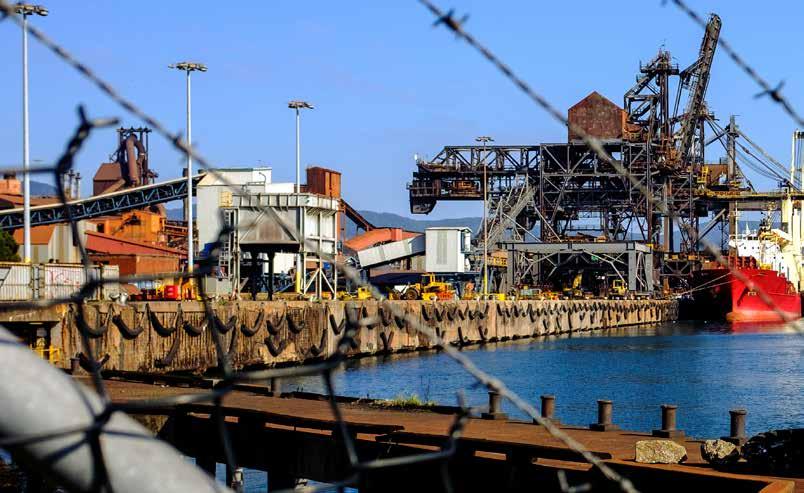
5 minute read
Rocking the boat
Maritime risks have risen in the age of Covid-19 despite reduced global trade. Kenneth Millard, Managing Director – Denmark, Envista Forensics, explains why fires in particular have become a major problem and how critical it is to mitigate and assess the losses as quickly as possible
The maritime insurance industry has experienced relative stability in terms of insurance risk and claims volume compared to other lines of business, such as property or liability that can be drastically impacted by weather and other environmental factors.
However, over the last year, there has been a sudden surge in maritime accidents. This comes at a time when Covid-19 has introduced several new risks and is endangering long-term safety improvements for maritime stakeholders.
Whether it be new liability considerations, disruptions to maintenance or port inspections, or travel restrictions, the risks are abundant and evolving every day.
This analysis will focus on containership fires, how specifically COVID-19 has impacted the volume and severity of container fires and what maritime stakeholders need to know to navigate these complex incidents.
BY THE NUMBERS
In February 2020, supply issues in China led to the first wave of “blank sailings”, leading to the withdrawal of 36% of Asia to Europe sailings and 28% of transpacific haul capacityi. By May 2020, as global lockdowns went into effect, 11% of the world’s container fleet was idle.
Despite reduced vessel use because of the pandemic, large fires on cargo vessels remain a serious problem and are on the riseii. Disruption of essential maintenance, lack of access to spare parts, and reduced or delayed surveys and port inspections pose risks such as unsafe practices and undetected defective equipment.
These are all factors that lead to increased fire risk. Additionally, decreased use can lead to mechanical issues with these vessels which can also lead to fires.
According to the Allianz 2019 Safety and Shipping Review, 13% of maritime claims, including total loss, are caused by fires and explosionsiii. In the US alone, containership fires account for over $500m annually.
WHY SO RISKY?
The big question is, why are containership fires so risky? Firstly, fires on board marine vessels can be hard to detect early and are extremely difficult to fight. If the burning container is stowed high and far from the lashing bridge, it can be challenging for firefighters to reach and extinguish.
According to HydroPen, a provider of fire suppression solutions, these fires happen, on average, every one-to-two months, and an average 25–30% of cargo claims costs are fire relatediv .
Additionally, the increase in size and complexity of containerships that the industry has experienced over the last decade is only intensifying the risks associated with container fires.
Cargo figures presented by the Organisation for Economic Co-operation and Development (OECD) suggest that the scale of modern 22,000 TEU vessels increases the risk of having a container fire onboard by a factor 4v .
So, whether it be the remote location of container ships while at sea or the size and scale of cargo being carried, container fires on board are inherently extremely dangerous and pose many risks.

FIRST RESPONSE ROOT CAUSE
Following fires onboard containerships, it is also vitally important to identify the root cause of the incident. Whether to determine coverage, assign liability, or pursue subrogation, all impacted systems and equipment need to be fully evaluated.
Was the incident related to a faulty product or improper installation? Was there a service, inspection or maintenance issue? Answering these questions is paramount, and stakeholders should proactively engage experienced marine and fire investigation experts to conduct origin and cause investigations into where and what started the fire, and why and how certain systems or equipment caught fire.
operational risks.
Time is of the essence when it comes to mitigating equipment, system, or cargo damage from corrosion. It is important not to power on equipment that exhibits loss related contaminants. Prematurely powering on equipment contaminated with conductive matter can cause electrical short circuits, damaging systems that may not have sustained functional damage as a result of the fire incident.
Delaying damage assessment, even by hours or days, can have substantial negative impacts on the repairability of equipment and cargo, and often results in severe financial consequences.
When a containership fire starts, the first priority, and naturally the most important, is to stop the fire as quickly CONCLUSION and safely as possible to reduce the risk of loss of life or The last year has posed incredible challenges across many serious injury. The second priority is to prevent or remove industries, maritime included. While shipping levels have damage to the affected parts of the vessel, cargo, and/or decreased because of Covid-19 restrictions, the volume of equipment. incidents, including containership fires, has jumped. Idle vessels,
The smoke that is released during a fire carries soot, delayed maintenance and inspections, and exhausted crews have which consists mostly of carbon as well as a range of other led to numerous catastrophic incidents around the globe. chemical compounds. These chemicals For marine stakeholders, the coming months are crucial to can be extremely corrosive and conduc- ensuring the safety of marine vessel tive, depending on the composition of equipment and systems. Whether there the consumed matter. has been a fire incident or equipment and
For instance, chlorine accounts for a “Fires on board marine vessels can be systems need to be evaluated following significant portion of polyvinyl extended lay-up periods, engineers and chloride (PVC) mass. Once consumed hard to detect early and are extremely experts experienced with the maritime by a fire, even small concentrations of industry should be consulted. PVC byproduct are highly reactive and difficult to fight. If the burning container can cause corrosion. Already a major i https://link.springer.com/article/10.1057/ risk onboard containerships because of is stowed high and far from the lashing s41278-020-00180-5 ever-changing environmental ii https://www.agcs.allianz.com/news-andconditions, corrosion impacts to critical bridge, it can be challenging for fire- insights/expert-risk-articles/shipping-2020containership mechanical or electrical loss-trends-ro-ro.html systems can be catastrophic. fighters to reach and extinguish.’’ iii https://www.agcs.allianz.com/news-and-in-
Following a fire, it is critical that sights/news/safety-shipping-review-2019.htmtrained engineers and equipment l#:~:text=Safety%20%26%20Shipping%20 experts, experienced with marine vessels Kenneth Millard, Review%202019%3A%2046,of%20shipand their critical systems, fully evaluate Envista Forensics ping%20incidents%20is%20stable all impacted areas to assess the type and iv https://hydropenfire.com/ level of contamination and potential v https://www.oecd.org/












